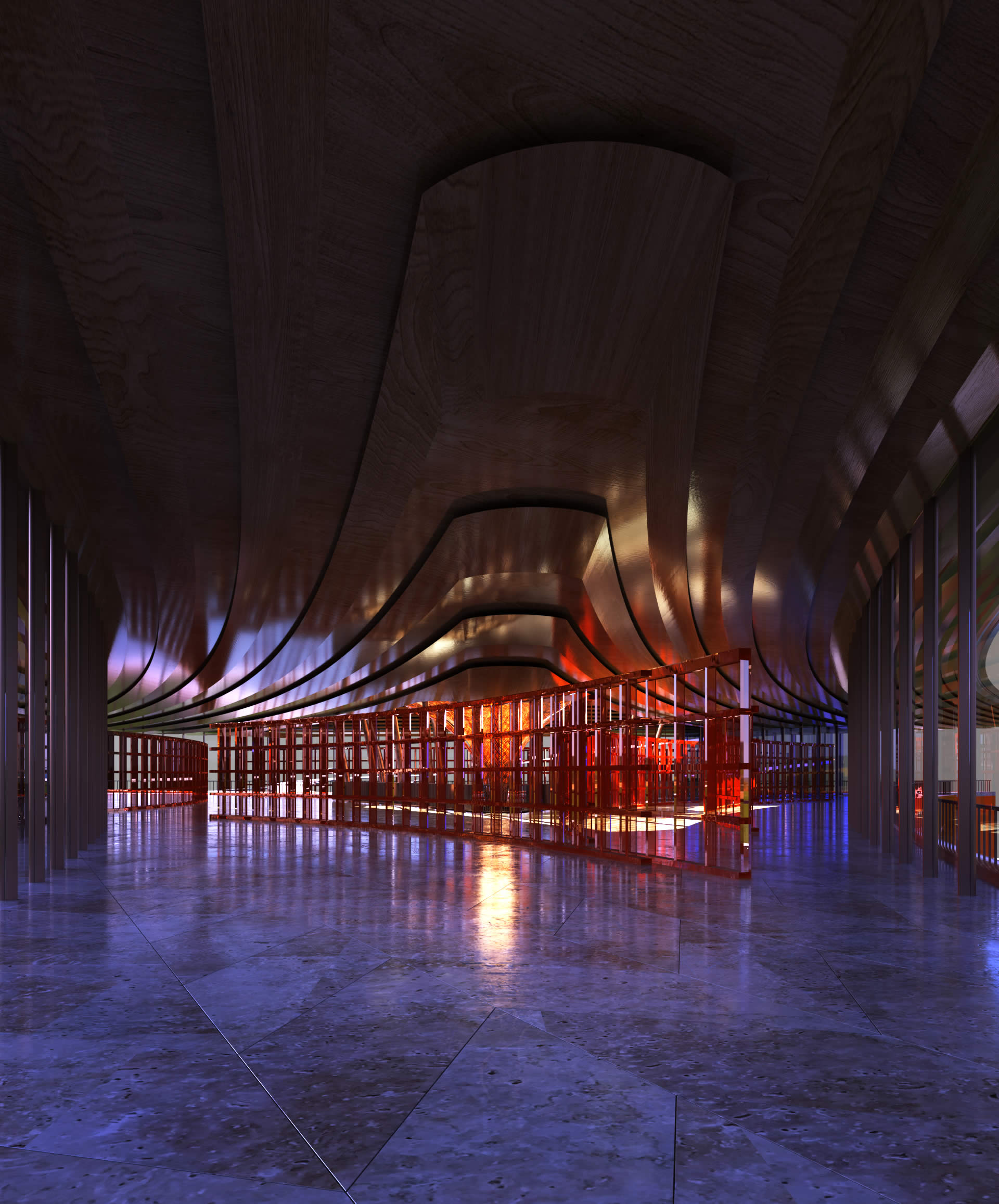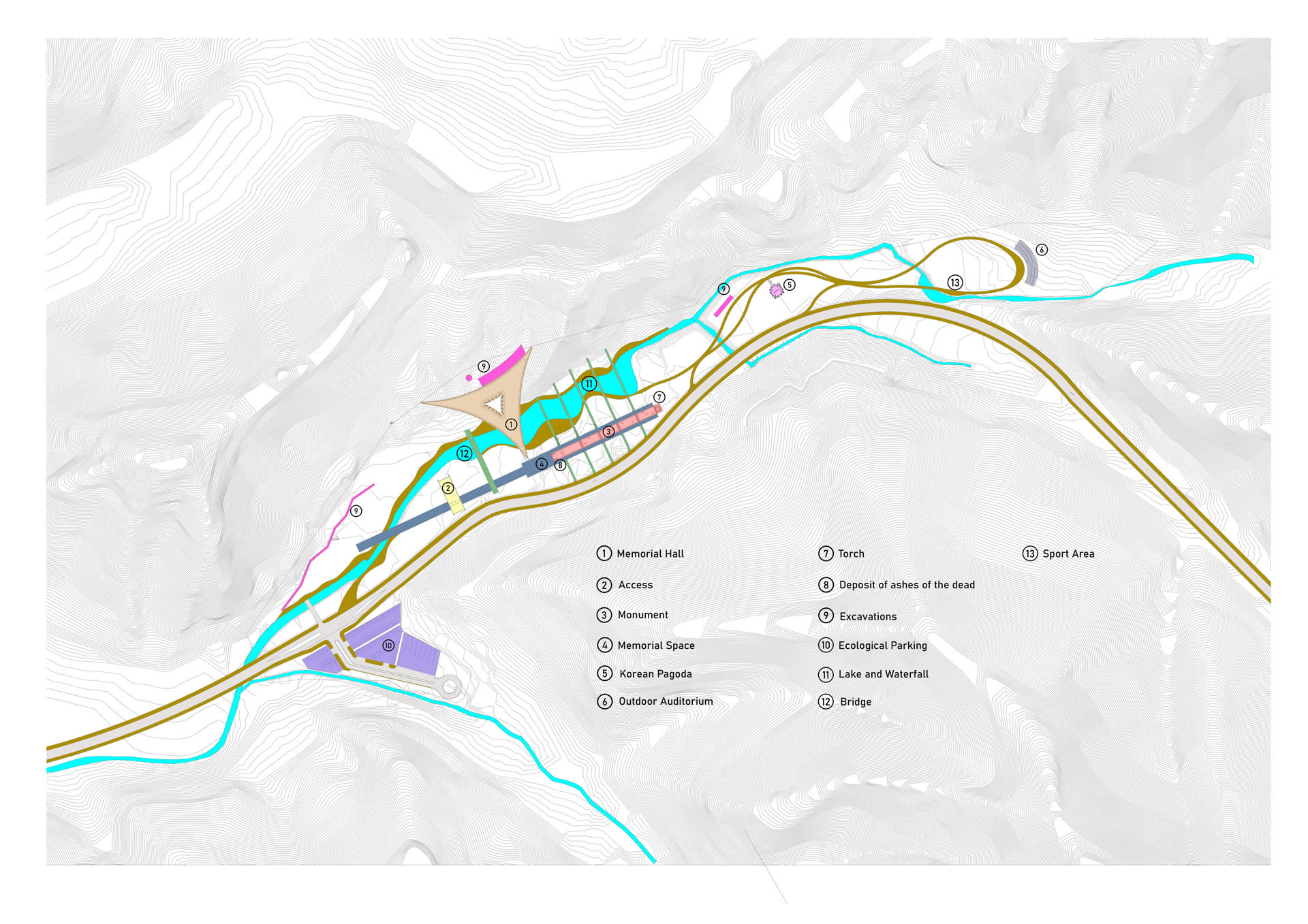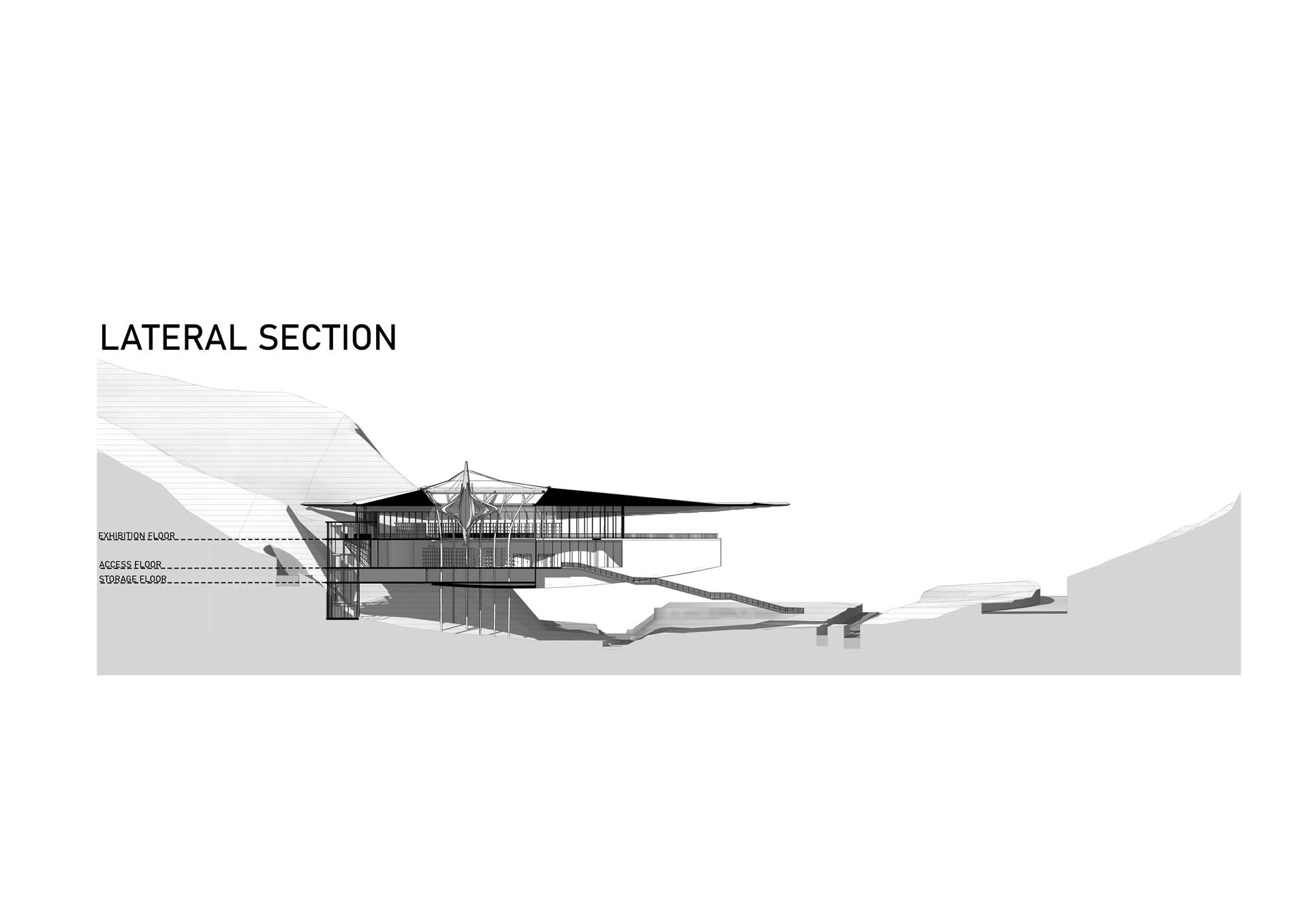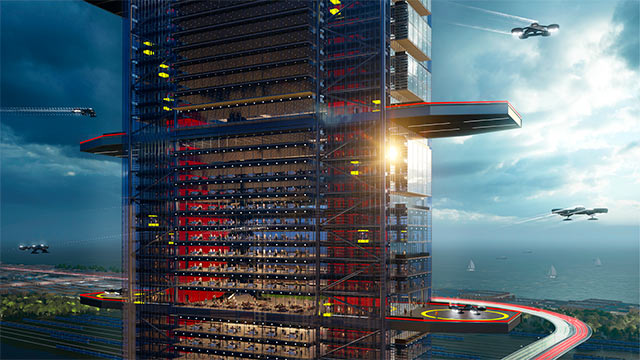Korean War. Memorial Park For Civil Victims.
The conceptual idea of our proposal arises from a significant analyses of the culture and the place, in this way we have managed to integrate the search excavations and the finding of murdered victims as a collective memory of the events which took place during the Korean War. For that purpose, we have used the pit that runs longitudinally between the Konryeong Stream and the Konryeong Street, from this linear space, we have designed our proposal. We have taken this particular grave, on behalf of all the others, to glorify dead civilians, generating the National Monument in Honor of the Civil Victims, an iconic monument that remains in the collective memory of the Korean People.
The 100x8m pit covered entirely in Korean white marble symbolizes the purity and innocence of the murdered civilians. Its background accompanies the unevenness of the terrain through waterfalls, adapting the project to the topography of the place. We have also developed a symbolic representation of the murdered people with the blocks of marble that emulate their coffins. At the beginning of the monument we find the Cinerary, the place where the ashes of the dead will be held. This area will be made in bronze casting, flanked on its side by two stairs that take us to the interior of the pit. A special place to meditate and get an insight on the transcendental meaning of this event has been designed in this area. On the opposite side, a flame torch lit 24 hours a day and 365 days a year identifies and glorifies the names of the people engraved on white marble with bronze plates on the superior base surrounding the mentioned grave. This monument marks the end of the trail along the access road.
The street, the structural axis that interconnects the rest of the functions, takes us from the car parking lot to the Memorial Hall, through the access to the park itself and in a comb-shape, interrelates the different uses. This street, with a strong direction towards the National Monument in Honor of the Civil Victims, is reinforced on each side by a row of Prenus Yedoensis trees.
The above mentioned street runs alongside the entrance building to the park made up of translucent walls that allow a glimpse of the strong imprint behind: a roof divided in two parts pointing towards the sky, without joining, symbolizes the beginning of the conflict between the two separate and opposed Koreas.
To the left of the street, we find a bridge that joins both margins and takes us to the secondary access of the Memorial Hall, in case the main access cannot be used, or to the Memorial Space, a venue for special events, where the flagpole with the Korean flag, the access to the Memorial Hall with its imposing staircase and the National Monument in Honor of Civil Victims are articulated.
The Memorial Space is an open space surrounded by memorable buildings and symbols, a large open view faces us with the lake and the waterfalls, the Memorial Hall floats on it. This area invites us to delve deeply into the recognition of the events that occurred in the place.
The Memorial Hall lifts off the ground like a bird's flight, frees up space of use allowing the free passage of visitors to one side of the Lake, its imposing presence is observed both from within the park and from the Konryong Street, trail that runs alongside it, its wings open to gain presence, more light and the entry of vegetation into the area.
The main entrance is through an imposing and majestic stairway that starts from the memorial space and reaches the level access, however, a second access is located on the other side of the river for people with reduced mobility and for supply services where several elevators take visitors and service suppliers directly to the different building levels and emergency stairs.
Once at the access level, we find a representative and symbolic double-height space that links both levels. The totality of the space it houses can be fully perceived here. This reception space is illuminated from above by a skylight from which a large Korean lamp made up of translucent, metal fabrics hangs, thus defining a representative landmark within the building.
Translucent, curved walls on both levels give a special dynamic to the space, directing and leading us to the different rooms and functions. Built in colored acrylic, these walls generate a welcoming atmosphere while they let us see the filing space through them. Placing objects is allowed and part of the wall use. These walls fulfill important functions, such as dividing and assembling the different spaces, or becoming useful to hold objects in exhibitions. However, this division does not block the visual conditions, on the contrary they allow us to see through them, generating more connected and interactive spaces.
An exfoliated, copper-sheet ceiling covers all rooms unifying their spatiality, generating a unique and valuable space for contemplation and meditation. This outward sloping ceiling invites us to enter the surrounding landscape. Korean white marble interior floors and exterior cladding add majesty and remind us of the purity and innocence of civilians killed in war. Large glass windows connect us with the world and the outdoor landscape. We have tried to preserve this landscape, not to alter it, respecting its topography and original vegetation, adapting the pedestrian paths to the topography of the area and taking advantage of the water course to generate water mirrors and falls among the different uneven levels. The lake generated as a result of the Konryeong stream reservoir serves as a water mirror for the Memorial Hall and generates silence in a landscape of calm waters that in turn is broken by five waterfalls that accompany the unevenness of the ground. A pedestrian walkway for contemplation and rest has been designed on both banks of the lake, five pedestrian footbridges which give shape to the different waterfalls cross the river. Two pedestrian paths stealthily merge into the natural landscape until we reach the place where the hillside begins. In this incredible spot, we set up an open-air auditorium that can be used for music concerts and / or quiet shows, as well as an endpoint and return from our walk. On this pathway, we have located different stops for meditation and rest, for example, one has been located in a Korean Gazebo and the other in a Fitness area, as well as places to rest distributed along the path. Native trees, such as Piceas koraimsis and Pinus Koraimsis complete the landscape so as not to damage it with foreign flora. Plants of Hibiscus Syriacus national flower have been grown to generate a boundary between the park and the sidewalk in order to diminish noise pollution created by cars moving from Kobryong Street to the Memorial Park.
| Location | Daejeon. Korea. |
|---|---|
| Type | Culture |
| Surface | 900.000 m2 |
| Year | 2020 |


















